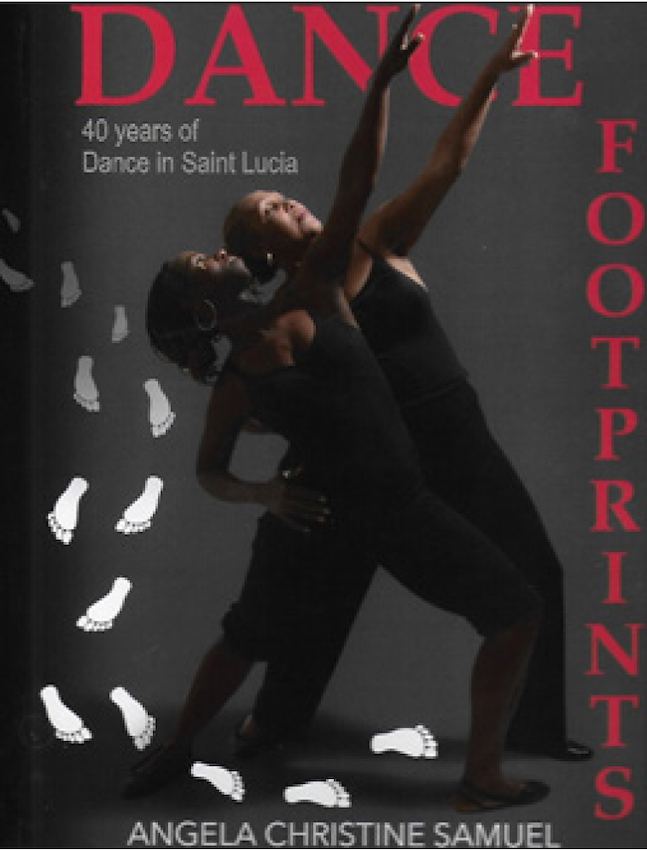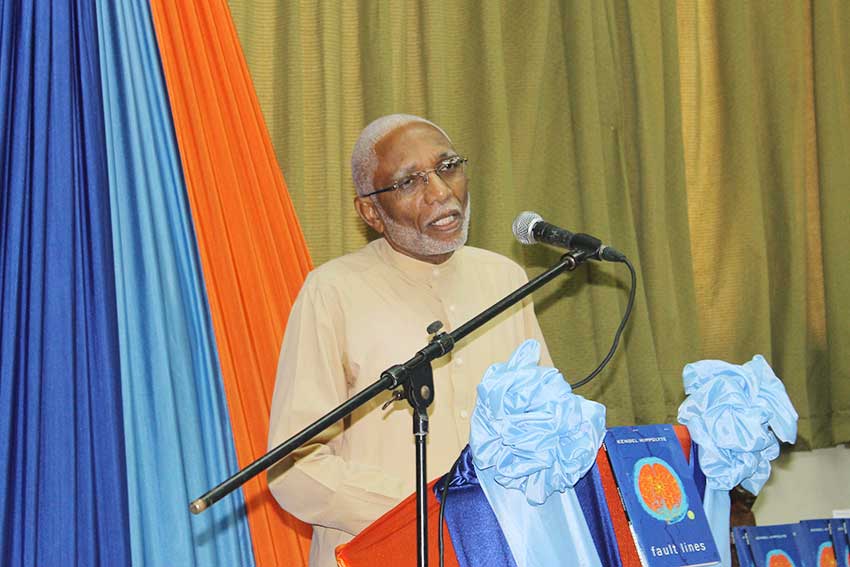Angela Christine Samuel’s Dance FOOTPRINTS: 40 years of Dance in Saint Lucia is the first published historical record of dance and dancers in Saint Lucia. Starting from the sixties, a time of arts and cultural renaissance and coming to today’s dancescape, she treats us to vignettes of these creative artists and choreographers, their performances, studio spaces (often school-rooms and church- halls), the long-forgotten alongside the well-recognized stars of those stages.

She covers the island’s dance activities from Castries to Babonneau, Dennery to Vieux Fort. Not ignored are the drummers who have always accompanied rehearsals and performances. This is a necessary, important compilation, a valuable addition to the very few histories we possess of the rich artistic heritage of Sent Lisi. The archival photographs will give great pleasure to dancers and readers. The book is appropriately dedicated to the late Julienne Virginia Alexander who led and oversaw the growth of numerous dancers and dance troupes for many years, including Ms. Samuel herself. And this impressive record of dance movements in Saint Lucia celebrates 42 years of Saint Lucia’s independence.
I have often thought that we do not have enough written histories of Saint Lucia. The long-lived Outlines of St. Lucia’s history by Rev. Charles Jesse, first published in 1956, with several editions following, was eventually superseded by A history of St. Lucia by Jolien Harmsen, Guy Ellis and Robert Devaux in 2012. Over the years, various pamphlets on diverse aspects of our history had appeared. In more recent times, modern political history has been recorded by journalist Rick Wayne, academic Tennyson Joseph and novelist Anderson Reynolds. A book on the Ravine Poisson disaster of 1938 was published in 2018 by Leonard Laurencin, while the late Clement Springer Williams wrote his memoirs of The Conway (Castries) in 2013. Admittedly, more of this kind of literature is appearing.

The Folk Research Centre which lost all its print and audio-visual holdings in a disastrous fire in 2018 had published pamphlets and booklets regularly on Saint Lucian culture including an annual periodical titled Lucian kaiso, covering the development of Saint Lucian calypso. A comprehensive handbook of Saint Lucian culture, The Road to Mount Pleasant was issued in 2017. In its articles and certainly in audio-visual productions, FRC provided researched publications on traditional literature, dance and music which were also broadcast on radio and television.
There have not been many biographies, certainly not of Sir George Charles or Sir John Compton, arguably the founding fathers of this nation. The FRC had published a personal memoir by Sir George Charles in 1994. A notable publication which featured short biographies of Saint Lucians who contributed to various areas of social and cultural life, including the arts, was Iconic Saint Lucians, edited by Barbara Jacobs Small in 2009. Mrs Jacobs-Small collaborated on a similar kind of book with Yasmin Solitahe Odlum titled Running in Heels: women and politics in Saint Lucia 1961-2016 that came out in 2016.
In 2020, in commemoration of Saint Lucia’s 41st Independence anniversary, the publication “From Inspiration to Creation: Saint Lucian Women Sustaining Lives and Livelihoods through the Arts” was launched. The book featured and celebrated 40 female Saint Lucian artistes who exemplify excellence in the arts, including entrepreneurs, arts educators, and advocates for the arts. Sigma Greaves Francis, founder of the School of Art and Design, was the author of the book The project was funded by the Saint Lucia National Commission for UNESCO.
Saint Lucia’s contribution to Caribbean arts and culture is not insignificant. In literature, art, music, theatre, dance, we have produced artists and work that have received acclaim beyond our shores. Yet published records of those achievements are relatively few. Thankfully, biographies of our two Nobel laureates have been written by non-Saint Lucian authors.

The major painter of his generation Sir Dunstan St. Omer does not have a coffee-table book of his distinctive Saint Lucian art or a biography. The only local artist with such a record of his work is Llewellyn Xavier, with his Life and Work published by Macmillan in 2007.
The musical achievements of persons like Charles Cadet, Dame Sesenne Descartes, Ronald Boo Hinkson, Luther Francois and many others; major calypsonians like Invader, Pep, Ashanti, Lady Leen, Minelle, Herb Black and others – their lives and work are not to be found within book covers, leaving a needed record for generations following.
In 2006, Kendel Hippolyte and I compiled and edited the 364-page, illustrated Saint Lucian Literature and Theatre: an anthology of reviews, which provided, through published reviews, a historical record of our literary and theatrical activity from 1948-2006. Theatre groups like the Saint Lucia Arts Guild, the Creative and Performing Arts Society, the Lighthouse Theatre and others still remain without a comprehensive recording and analysis of their many years of productions, their plays, directors and actors.
I have mentioned all these to illustrate how outstanding and necessary is the achievement of Christine Samuel in the compilation of this 40-year history of dance in Saint Lucia. In the words of Embert Charles writing in the Foreword, Dance Footprints is ‘the most comprehensive and authoritative history of modern dance organisations in Saint Lucia.” I would like to see similar works for the visual arts, music, theatre groups. Books that present a record (well-illustrated like this one) and also some analysis of organization, challenges, successes, failures, personalities.
Dance Footprints covers the work of twenty-six dance groups, many admittedly short-lived. An impressive catalogue of names rolls out many dancers well-known in the wider society and many, like the recently deceased Anthony Cocky JnBaptiste, no longer with us.
Saint Lucia has never been able to establish a National Dance Company or a National Theatre Company. Between 2000-2002, Ms. Samuel did try to shape a national dance company with her St. Lucia Dance Theatre Company and presented quality work at home and abroad. Unfortunately, the sudden death of one of her leading dancers, Aizi Alexander in 2002, proved too much for the group which dissolved soon after.
A book like this and the few other similar historical records of creative and artistic activity, should move government organisations like the Cultural Development Foundation (which supported generously this well-designed and attractive book) to come again with fresh vigour and resolve to provide more opportunities and facilities for our creative artists. Ministries of Creative Industries, Culture, Education ought by now, 42 years into national independence, to be convinced of the importance of creative arts to our development as a mature people.
I would like to see a Saint Lucian Creative Arts Centre that provides training, performing, exhibition and publishing avenues for Performing, Visual and Literary artists. For both new and veteran artists. The present National Cultural Centre site (a tent gifted by the French government still passes for a cultural and performing centre) is ideally placed for this. And yes, when do we establish National Dance and Theatre Companies? Given the world-recognised achievements of many Saint Lucian artists, we are unnecessarily backward. The political will of policymakers has been lacking where these areas of arts development are concerned.
If Christine Samuel’s well researched and professionally-produced volume does anything, it should remind us that even as she celebrates many years of dance achievement, new, young creatives are emerging, who should not have to continue to struggle at the kinds of basic needs levels as these dancers honoured here, had to do. And our young creatives in all areas of the arts, including new areas like animation, astound us daily with their talent and genius.
Creative artists, the general citizenry and especially dancers past and present, Saint Lucians at home and abroad, owe a debt of gratitude to Ms Angela Christine Samuel for her Dance Footprints: 40 years of dance in Saint Lucia. Our national psyche, more than ever, needs these records and reminders of our potential, of our achievements.









![Simón Bolívar - Liberator of the Americas [Photo credit: Venezuelan Embassy]](https://thevoiceslu.com/wp-content/uploads/2025/12/Simon-Bolivar-feat-2-380x250.jpg)

Thank you for the article. Where can you find and purchase this book?